Diane: Today, we enjoyed the ruins in and around Trujillo. Due to the late discovery of several tombs near Chiclayo and the painstaking excavation work, the Chiclayo-area museums house a splendid collection of artwork found at these sites. The same can not be said of the ruins themselves. Typically all that is left are huge mounds of mud-covered bricks that must have been indistinguishible from the surrounding hills, when they were recently found. On the other hand, in Trujillo, the passage of time has been a bit gentler on the adobe sites. Perhaps it is a bit drier here or perhaps the El Niño phenomena have not been as fierce over the centuries.
Trujillo was the center of Chimú culture from about 900 A.D. to 1470 A.D. The first Chimú site we visited was Huaca Arco Iris (Rainbow Pyramid), built around 1200 A.D. The walls were covered in relief. In its heyday, the whole thing was painted yellow. Even as few as 20 years ago, it was possible to see some of the yellow tint from the original paint. But the intervening El Niños put an end to that. Michael, from the Casa Clara guesthouse where we are staying, was our first English-speaking guide since the Galapagos many months ago. As we stood in front of one of many highly-decorated walls, he explained the symbolism, cultural details, and many possible interpretations of what was in front of us.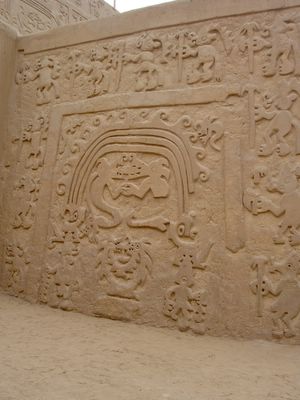
The most obvious interpretation of the parallel curved lines is a rainbow. However, there is an alternate explanation, that parallel lines are a symbolic representation of a serpent. At either end of the rainbow/serpent are two human figures. Underneath are two lizard-like figures. Sea otters create a border around the entire scene. One overall interpretation is that of a rain dance. Another is that of a fertility ritual. Another way to look at this wall is as three layers, representing the heavens, land, and the sea. Take your pick.
Another area has stylized birds and cats repeated over and over. They didn't look much like birds or cats to me, so I have trouble identifying them in my photos.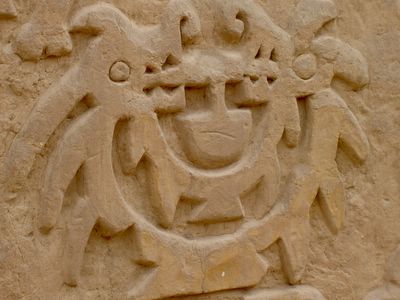
The pair above has what looks like a tumi hanging between them. The tumi was a round broad knife that all the museums indicate was used for decapitation. Today I learned that the common people used smaller and larger versions of tumis for everyday tasks.
On the next level there are small square rooms, each with a square hole in the middle of the floor. Archaeologists guess that these were storage areas, perhaps for items used in religious ceremonies. Looking down from above, they gave me the feeling of holding cells. Since the rooms have no doors for entry or exit, most explanations seem implausible.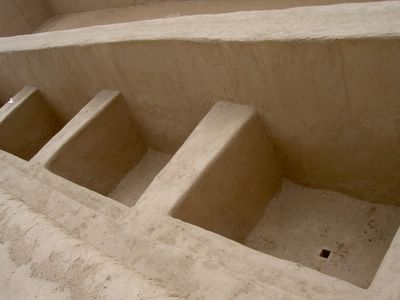
Huaca Arco Iris is entirely surrounded by a 6-meter thick adobe wall. With such dramatic protection, it must have been an important site in its time. Even so, it was eventually forgotten/abandoned and entirely covered by sand.
The next set of ruins we visited was Chan Chan, the largest adobe city in the world. Chan Chan was a sculpted and painted adobe city surrounded by a 25' tall wall. It was composed of palaces, patios, passageways,
terraces, towers, gardens, homes, mauseleums, ramps, a huge well (a big surprise in such desert surroundings),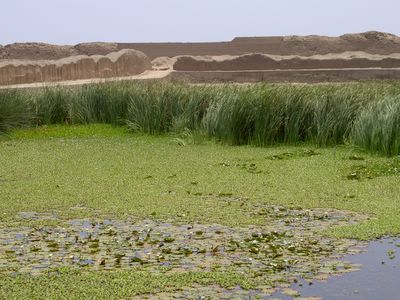
and ceremonial centers. In the entry area, the interior walls are decorated with reliefs of sea otters - lots of sea otters - a fertility symbol.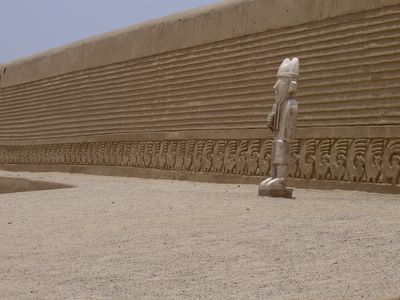
Another common motif in Chan Chan was that of diamond-shaped fishing nets. Whole walls are made to look like such nets.
Our guide told us that when he takes groups of French tourists around this net area, someone always asks if the Chimú didn't use these walls to store things. From their cultural bias, they see the potential for large areas devoted to wine storage. Of course, we all bring such biases to our analysis of these ancient buildings and artifacts. We have yet to see one Peruvian museum or archaeological site that gives a coherent explanation of the items on display. Guidebooks help, but pale in comparison to the numerous competing theories that have arisen to explain these "lost civilizations". Understanding such cultures, that have no accompanying written language, or even classifying them, requires as much imagination as analysis. And our biases probably make it impossible to come up with a correct analysis.
There are conscientious efforts aimed at preservation as well as restoration at Chan Chan. For instance, the tops of many walls have been capped with a protective cement-like layer that looks a bit like adobe, but does not let water in. This will protect the site from turning into mud mounds. Some areas have permanent canopies hanging over them. Many areas that are currently under excavation are totally cordoned off.
The Chimú were also into human sacrifice. There was a relatively recent discovery that came with the 1983 El Niño rains. These rains uncovered two adolescent sacrificial victims. It is possible that there are hundreds of such victims buried in the same area. Archaeologists believe that at the back of the royal palace compound, the royal tomb is surrounded by niches where more sacrifice victims were placed.
In its glory days, Chan Chan housed an estimated 30,000-60,000 people. It is located a couple of kilometers from the ocean, which we could hear clearly even from that distance. Although the tombs were once filled with precious gold and silver objects, they have been continuously looted over the centuries starting with the Incas in the 1500s. It is a wonder that such a large city prospered in the middle of a desert. I also wonder whether the large spaces dedicated to ceremonial uses demonstrate the importance of religion to the Chimú or whether they were merely a display of power or a form of control.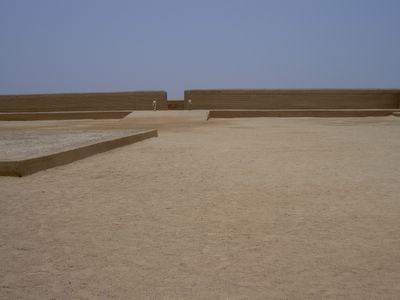
At this point in my archaeological explorations of Northern Peru, even without having seen the glories of Machu Picchu or the Nasca Lines, I think Peru needs a specialty license plate with the slogan "Peru: One Big Dig".

No comments:
Post a Comment